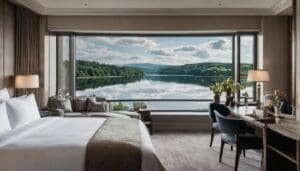The Fascinating Crumlin Road Gaol Belfast: 5 Facts and more

Updated On: April 15, 2024 by Ciaran Connolly
Crumlin Road Gaol is a testament to Belfast’s tumultuous past and enduring spirit. Nestled in the heart of Northern Ireland’s capital, this formidable Victorian-era prison has witnessed over 150 years of history, from its inception in 1845 to its closure in 1996. Today, it is a historical landmark and a captivating tourist attraction, drawing visitors worldwide to explore its corridors and uncover the stories within its walls.
History of Crumlin Road Gaol

Crumlin Road Gaol is a former prison in Belfast, Northern Ireland. The jail, designed by Sir Charles Lanyon, was built between 1843 and 1845. It’s the only Victorian-era prison remaining in Northern Ireland and was one of the most advanced prisons of its day. On 31 March 1996, the Crumlin Road jail officially closed. The closure ended a 150-year history of imprisonment, Belfast conflict, and executions.
Built within a five-sided walled site, Crumlin Road Gaol had four wings fanning from a central area known as The Circle. The Grade A listed building is part of the city’s social fabric, and the first inmates, who were forced to walk from Carrickfergus Prison in chains, arrived in 1846.
A Crucible of Conflict
The 20th century witnessed the escalation of tensions in Northern Ireland, culminating in the outbreak of the Troubles, a protracted conflict between nationalist Catholics and unionist Protestants. During this period, the Crumlin Road Gaol became a focal point of political strife, with its cells often filled with individuals deemed threats to the established order.
The prison’s most infamous chapter unfolded during the early years of the Troubles, as it became a symbol of British authority and oppression in the eyes of many nationalists. Numerous high-profile inmates, including members of paramilitary organizations such as the Irish Republican Army (IRA) and the Ulster Volunteer Force (UVF), were incarcerated within its walls, their struggles for self-determination echoing across the corridors of confinement.
Voices from Within

With its labyrinthine corridors and claustrophobic cells, the Crumlin Road Gaol harbours countless stories of human suffering and resilience. From the poignant letters of imprisoned activists to the whispered confessions of remorseful souls, the walls of this formidable fortress bear witness to the full spectrum of the human experience.
One such tale is that of Bobby Sands, an IRA member who gained international prominence during his hunger strike in 1981. Sands, along with nine other republican prisoners, embarked on a hunger strike to protest the British government’s refusal to recognize them as political prisoners. Despite facing immense physical and psychological torment, Sands remained steadfast in his convictions, ultimately sacrificing his life in pursuit of his ideals.
The Maze Prison Escape
In 1983, Crumlin Road Gaol witnessed one of modern history’s most audacious prison escapes. A group of Republican inmates, incarcerated for their involvement in paramilitary activities, orchestrated a meticulously planned breakout from the high-security wing of the prison.
Using smuggled weapons, homemade tools, and sheer audacity, the prisoners overpowered guards and seized control of the H-Block section of the gaol. In a daring display of defiance, they tunnelled their way to freedom, evading capture and sparking a nationwide manhunt that captivated the public imagination.
The Maze Prison escape, as it came to be known, highlighted the inadequacies of the prison system and dealt a significant blow to the credibility of the British government’s security apparatus.
Beyond the Bars
In 1996, after more than 150 years of operation, the Crumlin Road Gaol ceased its function as a place of incarceration, marking the end of an era in Belfast’s history. However, rather than fading into obscurity, the gaol underwent a remarkable transformation, evolving into a symbol of reconciliation and remembrance.
Today, the Crumlin Road Gaol stands as a living museum, offering visitors a glimpse into its tumultuous past through guided tours and interactive exhibits. From the chilling confines of death row to the haunting remnants of the underground tunnel used for prisoner transport, each corner of the gaol resonates with echoes of its storied history.
Legends and Lore
Beyond its historical significance, Crumlin Road Gaol is also steeped in folklore and legend. Tales of ghostly apparitions and unexplained phenomena have long surrounded the gaol, captivating the imaginations of locals and visitors alike.
One of the most infamous legends is that of the “Grey Lady,” a spectral figure said to roam the gaol corridors. According to popular belief, the Grey Lady is the ghost of a former governess who tragically lost her life within the confines of the prison. Her restless spirit is said to wander the halls, searching for solace in the afterlife.
Touring the Gaol
The gaol has a deep and dark history that entices people to want to learn more about it. Today, it offers an exciting tour of facts, history, culture, and drama. Over its 150-year history, 17 men have been executed. During the tour, you will see prison life through the ages and the dark secrets that lie within. It’s something different.
The most exciting thing about visiting this jail is trying to picture the experience of those prisoners who spent most of their lives there. I also got permission to inspect the tunnel linking the courthouse on the other side of Crumlin Road to the hanging cell, Governor’s office, hospital, and graveyard.
On this tour, you can learn about ‘The Troubles’ and the Northern Ireland Conflict—many prisoners were heavily involved in Northern Ireland politics—or even catch a paranormal tour. Ghosts are reported to linger in the dark tunnel and basement under the jail. Are you brave enough to explore during a ghost tour? Can you stomach some paranormal activity?
Admissions
The entrance fees for the Crumlin Road prison differ according to your age. It’s 9 pounds for adults and 6.50 for children from 5 to 15 years old. It’s also free for those under 5 years old and 25 pounds for families. Crumlin Road Gaol has many significant events throughout the year, so be sure to check out their website for more.
Preservation and Restoration
Following its closure, Crumlin Road Gaol faced an uncertain future. However, thanks to dedicated preservation efforts, the historic landmark was saved from demolition and transformed into a museum and visitor attraction. Today, visitors can step back in time and explore the prison’s fascinating history through guided tours, interactive exhibits, and immersive experiences.
The restoration of Crumlin Road Gaol has been a labour of love. Meticulous attention to detail has preserved its original features and captured the essence of life within its walls. From the cold, damp cells to the haunting condemned man’s cell, every corner of the prison tells a story, offering insight into the harsh realities of incarceration in days gone by.
A Symbol of Reconciliation
In recent years, the Crumlin Road Gaol has emerged as a symbol of reconciliation and hope for the future. Its transformation from a place of confinement and despair to one of education and remembrance is a testament to the resilience of the human spirit.
Through its ongoing efforts to preserve and promote Northern Ireland’s cultural heritage, the gaol fosters dialogue and understanding among communities divided by centuries of strife. By acknowledging past mistakes and embracing a shared vision of peace and reconciliation, the Crumlin Road Gaol stands as a beacon of hope for future generations.
Check out More Videos of Crumlin Road Gaol below:
Crumlin Road Gaol, Belfast
Visiting the Crumlin Road Gaol
Conclusion
In the annals of Belfast’s history, the Crumlin Road Gaol occupies a unique place. It serves as a reminder of past injustices and a beacon of hope for the future. Its imposing façade stands as a testament to the resilience of the human spirit, enduring despite the ravages of time and conflict.
As visitors wander through its hallowed halls, they are confronted with the stark realities of imprisonment and the enduring power of redemption and reconciliation. In the words of poet and Nobel laureate Seamus Heaney, “History says, Don’t hope on this side of the grave. But then, once in a lifetime, the longed-for tidal wave of justice can rise, and hope and history rhyme.”
In the Crumlin Road Gaol, hope and history converge, offering a glimpse into the soul of Belfast and the enduring quest for peace and understanding in a world scarred by division and strife.
Have you ever had the chance to visit this historic Jail? We would love to hear about your experiences:)
Also, don’t forget to check out our other blogs that might interest you such as The Titanic Museum, Dead Centre Tours and The History of The Troubles of Belfast, Belfast Peace Walls, City Hall Belfast, A Walking tour of SS Nomadic.






